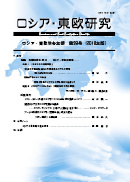After the collapse of the Soviet Union new enthusiasm for Japan, often dubbed “New Japonism,” emerged in Russia. Along with Murakami Haruki, manga and anime, etc., geisha, one of the main representations of Japan abroad since the end of the 19
th century, evoked a fresh interest. The new edition of the Russian translation of Loti’s
Madame Chrysanthème, the translation of Nakamura Kiharu’s biographical work, the popularity of Arthur Golden’s novel as well as the success of the movie,
Sayuri, based on the novel, are just few examples of this revived interest in geisha. Moreover, some contemporary Russian writers themselves created works, incorporating Japanese themes in their works, including the representation of geisha. Olga Lazoreva’s trilogy,
Russian Geisha, is a story about a Russian girl who undertakes the training as a geisha after her lover dies in connection with the Aum Shinrikyo sect and the Tokyo sarin subway incident. It also is a work, created under New Japonism in Russia and, as reflected in the title, represents geisha in her own way. Lazoreva was invited to write a novel about geisha by a publishing house in the light of popularity of Golden’s novel,
The Memoirs of Geisha, and its film version in Russia. Thus at the first glance it would seem that Lazoreva merely reproduced the theme of geisha, found in other works. Besides, even though Lazoreva in her work constantly stresses the fact that geisha is not a prostitute, the explicit descriptions of sexuality in the work, would create a contrary impression that this trilogy is just another representation of exotic Japanese sexuality as exotic one.
The fact that geisha, represented in Lazoreva’s work, is of mixed origins plays an important role. By creating an untypical geisha character, closely connected to Russia, Lazoreva’s work not merely represents the exotic Other, but, through the protagonist-geisha, being both Japanese and Russian, also discloses a concealed self-representation of the Russians. This paper is thus an attempt to explore the representation of geisha, its peculiarities and significance in contemporary Russian literature by focusing on the trilogy
Russian Geisha, which would shed a new light on the construction of the modern Russian subjectivity itself.
The work will analyze the representation of geisha focusing on the following three points: firstly, the analysis of the way Lazoreva operates with the stereotype of geisha, often perceived as a prostitute; secondly, the comparison of the representation of geisha in Lazoreva’s work to the representation of Russian women in general in the context of some other contemporary Russian literary works, such as
Chapaev and Void by Viktor Pelevin and
The Intergirl by Vladimir Kunin, the works that describe Russian women in their peculiar ways. Lastly, on the basis of these analyses, this paper will try to clarify the relevance of
Russian Geisha to the socio-economic situation of the post-Perestroika and post-Soviet Russia and to its gender politics.
抄録全体を表示
